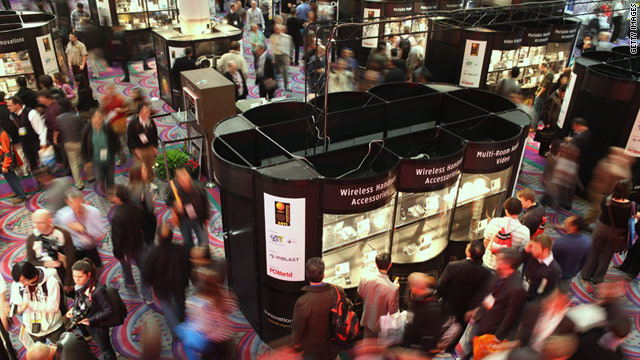
- As CES comes to a close, we take a look back at some of the show's biggest trends
- 3-D spread from TVs to cameras and laptops, and tablets were everywhere
- Gimmicky gizmos and promotional-friendly celebrities also were big draws
Las Vegas (CNN) -- After tapping dozens of greasy touchscreens, getting our ears pinched by 3-D glasses and braving crowds that would make a penguin claustrophobic, we members of the tech media said goodbye Sunday to the Consumer Electronics Show.
While the planet's biggest technology companies box up their prototypes and disassemble their grandiose booth displays, we're reflecting on the past week and what it could mean for the year ahead.
Here are five things we learned at CES:
1. 3-D isn't going away
Disappointing sales of TVs have not deterred technology and media companies from pursuing 3-D products.
We saw 3-D TVs, laptops, cameras, movies, games, portable devices and picture frames.
Three-dimensional TVs were a huge theme at last year's CES, too, although cost, shortage of 3-D content and those bulky special glasses made consumers wary. This year, we saw big steps in 3-D big-screen viewing without glasses, though little in the way of solidified products.
But in case the home 3-D craze falls completely flat, television makers are betting another trend may help them sell new TV sets or accessories. We saw all kinds of "smart TV" systems that connect the big screen to the content of the Web.
2. Android tablets are hot
Following the blazing success of Apple's iPad, practically every manufacturer with any kind of expertise in building screens, gadgets or software unveiled their own touchscreen tablets at CES.
Mobile industry watchers expect Google to repeat its success with the Android operating system for smartphones in the tablet category as well. The company demoed Honeycomb, its new Android 3.0 operating system for tablets, at CES to good reviews.
One prototype Honeycomb tablet, Motorola's Xoom for Verizon Wireless, got perhaps the biggest buzz. LG Electronics offered the G-Slate for T-Mobile, which also runs Honeycomb, but the company had nothing to show at CES besides a video.
There were dozens of other tablets running older versions of Android or a tablet-optimized version of Microsoft's Windows 7 operating system. Or, in Lenovo's case, both.
One disappointing trend, from a tech reporter's perspective, was the companies' reluctance to let the public handle tablets in person. Many devices were waved about on stage or displayed behind glass but not made available for show attendees to play with.
3. Celebs are great for hawking gadgets
What better way to promote an otherwise dull piece of equipment than with a familiar face?
Rapper Ludacris was in town to promote his upcoming line of headphones. Fellow musician T-Pain was hawking a microphone. And 49ers football legend Jerry Rice was scheduled to attend CES -- but bailed days before -- to promote a video game where his character competes against dogs. (No, that's not a joke.)
Lady Gaga, the official creative director for Polaroid (also not a joke), arrived about 40 minutes fashionably late to her event at the camera company's booth.
The pop star demonstrated a portable photo printer she said she designed herself, which she carries in her purse, and a bulky pair of sunglasses with a camera built in. Gaga encouraged the audience to buy the sunglasses and bring them to her concerts.
If Polaroid wanted to make a splash, it worked: Gaga's appearance produced a massive crowd, swarms of paparazzi and countless headlines. Whether anyone will actually buy the sunglasses is another matter.
4. Gimmicky things can get buzz
Acer's Iconia, a laptop with two touch-screens instead of a keyboard, won a gadget competition despite not demonstrating a working version of the product onstage.
The Iconia appears to face some of challenges. It has the heft of a laptop without the convenience of being able to type on physical keys.
Chinese computer maker Lenovo got some attention for its laptop hybrid with a removable touchscreen tablet -- despite the fact that the company showed off basically the identical gadget at CES 2010.
And several companies introduced home appliances -- refrigerators, ovens and washing machines -- with internet connections and touchscreens. Your oven, for example, can send you a text message when your roast is about done.
Of course, declaring something a gimmick before it's had ample time to be accepted or rejected by consumers is probably not fair. Who knows? Maybe people will really want to tweet from their fridge.
5. Gadget 'Transformers'
Sometimes being a really good phone, laptop or Web-connected entertainment center isn't enough. Take Motorola's Atrix 4G ![]() , for example. It's all three.
, for example. It's all three.
The Android smartphone is super-fast, with a dual-core processor inside. But like in the hit "Transformers" movie, the big reveal comes when this truck becomes Optimus Prime.
The Atrix can dock to a laptop shell or monitor to become a sort of Android desktop computer, complete with Firefox for full Web browsing. Hook it up to a TV, and the videos and music stored on the device can be played on the big screen using a media-center system.
Samsung's Sliding PC 7 Series laptop starts out as a touch-screen Windows tablet. But users can pull out a hidden keyboard, similar to the ones on slider phones, which turns the tablet into a sort of netbook.
To see shots of that computer and other gadgets, here's a gallery of some of the buzzier products shown at the world's biggest tech trade show. And for more, check out all of our coverage from CES.
No comments:
Post a Comment